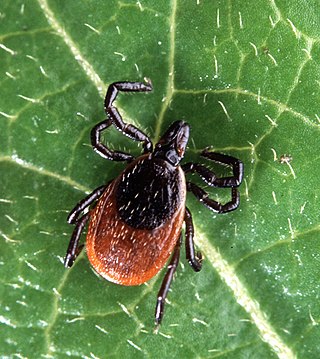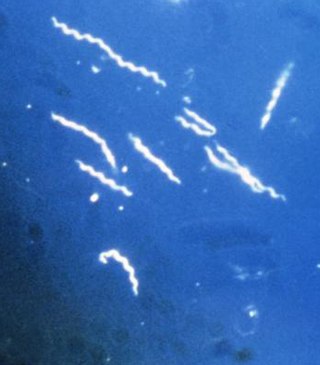
Lyme disease, also known as Lyme borreliosis, is a vector-borne disease caused by Borrelia bacteria, which are spread by ticks in the genus Ixodes. The most common sign of infection is an expanding red rash, known as erythema migrans (EM), which appears at the site of the tick bite about a week afterwards. The rash is typically neither itchy nor painful. Approximately 70–80% of infected people develop a rash. Early diagnosis can be difficult. Other early symptoms may include fever, headaches and tiredness. If untreated, symptoms may include loss of the ability to move one or both sides of the face, joint pains, severe headaches with neck stiffness or heart palpitations. Months to years later, repeated episodes of joint pain and swelling may occur. Occasionally, shooting pains or tingling in the arms and legs may develop. Despite appropriate treatment, about 10 to 20% of those affected develop joint pains, memory problems, and tiredness for at least six months.

A rash is a change of the skin that affects its color, appearance, or texture.

Cellulitis is usually a bacterial infection involving the inner layers of the skin. It specifically affects the dermis and subcutaneous fat. Signs and symptoms include an area of redness which increases in size over a few days. The borders of the area of redness are generally not sharp and the skin may be swollen. While the redness often turns white when pressure is applied, this is not always the case. The area of infection is usually painful. Lymphatic vessels may occasionally be involved, and the person may have a fever and feel tired.

Pityriasis rosea is a type of skin rash. Classically, it begins with a single red and slightly scaly area known as a "herald patch". This is then followed, days to weeks later, by an eruption of many smaller scaly spots; pinkish with a red edge in people with light skin and greyish in darker skin. About 20% of cases show atypical deviations from this pattern. It usually lasts less than three months and goes away without treatment. Sometimes malaise or a fever may occur before the start of the rash or itchiness, but often there are few other symptoms.

Lichen sclerosus (LS) is a chronic, inflammatory skin disease of unknown cause which can affect any body part of any person but has a strong preference for the genitals and is also known as balanitis xerotica obliterans (BXO) when it affects the penis. Lichen sclerosus is not contagious. There is a well-documented increase of skin cancer risk in LS, potentially improvable with treatment. LS in adult age women is normally incurable, but improvable with treatment, and often gets progressively worse if not treated properly. Most males with mild or intermediate disease restricted to foreskin or glans can be cured by either medical or surgical treatment.
Pityriasis lichenoides chronica is an uncommon, idiopathic, acquired dermatosis, characterized by evolving groups of erythematous, scaly papules that may persist for months.

Bullous pemphigoid is an autoimmune pruritic skin disease that typically occurs in people aged over 60, that may involve the formation of blisters (bullae) in the space between the epidermal and dermal skin layers. It is classified as a type II hypersensitivity reaction, which involves formation of anti-hemidesmosome antibodies, causing a loss of keratinocytes to basement membrane adhesion.

Polymorphous light eruption (PLE) presents with itchy red small bumps on sun-exposed skin, particularly face, neck, forearms and legs. It generally appears 30 minutes to a few hours after sun exposure and may last between one and 14 days. The bumps may become small blisters or plaques and may appear bloody,often healing with minimal scarring.

Erythema migrans or erythema chronicum migrans is an expanding rash often seen in the early stage of Lyme disease, and can also be caused by southern tick-associated rash illness (STARI). It can appear anywhere from one day to one month after a tick bite. This rash does not represent an allergic reaction to the bite, but rather an actual skin infection of one of the Lyme bacteria species from the genus Borrelia. The rash's name comes from Neo-Latin for "Redness migrating."

Borrelia is a genus of bacteria of the spirochete phylum. Several species cause Lyme disease, also called Lyme borreliosis, a zoonotic, vector-borne disease transmitted by ticks. Other species of Borrelia cause relapsing fever, and are transmitted by ticks or lice, depending on the species of bacteria. A few Borrelia species as Candidatus Borrelia mahuryensis harbor intermediate genetic features between Lyme disease and relapsing fever Borrelia. The genus is named after French biologist Amédée Borrel (1867–1936), who first documented the distinction between a species of Borrelia, B. anserina, and the other known type of spirochete at the time, Treponema pallidum. This bacterium must be viewed using dark-field microscopy, which make the cells appear white against a dark background. Borrelia species are grown in Barbour-Stoenner-Kelly medium. Of 52 known species of Borrelia, 20 are members of the Lyme disease group, 29 belong to the relapsing fever group, and two are members of a genetically distinct third group typically found in reptiles. A proposal has been made to split the Lyme disease group based on genetic diversity and move them to their own genus, Borelliella, but this change is not widely accepted. This bacterium uses hard and soft ticks and lice as vectors. Testing for the presence of the bacteria in a human includes two-tiered serological testing, including immunoassays and immunoblotting.

Granuloma annulare (GA) is a common, sometimes chronic skin condition which presents as reddish bumps on the skin arranged in a circle or ring. It can initially occur at any age, though two-thirds of patients are under 30 years old, and it is seen most often in children and young adults. Females are two times as likely to have it as males.

Pemphigoid is a group of rare autoimmune blistering diseases of the skin, and mucous membranes. As its name indicates, pemphigoid is similar in general appearance to pemphigus, but, unlike pemphigus, pemphigoid does not feature acantholysis, a loss of connections between skin cells.

Lyme disease, or borreliosis, is caused by spirochetal bacteria from the genus Borrelia, which has 52 known species. Three main species are the main causative agents of the disease in humans, while a number of others have been implicated as possibly pathogenic. Borrelia species in the species complex known to cause Lyme disease are collectively called Borrelia burgdorferisensu lato (s.l.) not to be confused with the single species in that complex Borrelia burgdorferi sensu stricto which is responsible for nearly all cases of Lyme disease in North America.
Allen Caruthers Steere is an American rheumatologist. He is a professor of rheumatology at Harvard University and previously at Tufts University and Yale University. Steere and his mentor, Stephen Malawista of Yale University, are credited with discovering and naming Lyme disease, and he has published almost 300 scholarly articles on Lyme disease during his more than 40 years of studies of this infection. At a ceremony in Hartford, Connecticut in 1998, Governor John G. Rowland declared September 24 to be "Allen C. Steere Day".

Karl Herxheimer was a German-Jewish dermatologist who was a native of Wiesbaden.
Neuroborreliosis is a disorder of the central nervous system. A neurological manifestation of Lyme disease, neuroborreliosis is caused by a systemic infection of spirochetes of the genus Borrelia. Symptoms of the disease include erythema migrans and flu-like symptoms.
Acrodermatitis /ac·ro·der·ma·ti·tis/ is a childhood form of dermatitis selectively affecting the hands and feet and may be accompanied by mild symptoms of fever and malaise. It may also be associated with hepatitis B and other viral infections. The lesions appear as small coppery-red, flat-topped firm papules that appear in crops and sometimes in long linear strings, often symmetric. It is a diffuse chronic skin disease usually confined to the limbs, seen mainly in women in Northern, Central, and Eastern Europe, and characterized initially by an erythematous, oedematous, pruritic phase followed by sclerosis and atrophy. It is caused by infection with Borrelia burgdorferi.
Gianotti–Crosti syndrome, also known as infantile papular acrodermatitis, papular acrodermatitis of childhood, and papulovesicular acrolocated syndrome, is a reaction of the skin to a viral infection. Hepatitis B virus and Epstein–Barr virus are the most frequently reported pathogens. Other viruses implicated are hepatitis A virus, hepatitis C virus, cytomegalovirus, coxsackievirus, adenovirus, enterovirus, rotavirus, rubella virus, HIV, and parainfluenza virus.
Borrelia lusitaniae is a bacterium of the spirochete class of the genus Borrelia, which has a diderm (double-membrane) envelope. It is a part of the Borrelia burgdorferisensu lato genospecies and is a Gram-negative bacterium. B. lusitaniae is tick-borne; he type strain is PotiB2. It can be pathogenic, being involved in cases of Lyme borreliosis. A species of tick, Ixodes ricinus, is the host of B. lusitaniae. It is thought to have originated from Portugal and has since spread to parts of Europe and North Africa. Lizards of the family Lacertidae are now believed to be important reservoir hosts of this bacterium.










